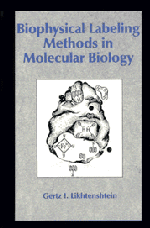Book contents
- Frontmatter
- Contents
- Preface
- Abbreviations
- 1 The method of spin labeling
- 2 Double-labeling techniques
- 3 Fluorescent labeling methods
- 4 Triplet labeling methods
- 5 Mössbauer spectroscopy, electron scattering, and other labeling methods
- 6 Studies of proteins and enzymes: structure, dynamics, and mechanism of action
- 7 Structure and dynamics of membranes
- 8 Nucleic acids and other biological systems: biological assays
- Conclusion
- References
- Index
5 - Mössbauer spectroscopy, electron scattering, and other labeling methods
Published online by Cambridge University Press: 29 January 2010
- Frontmatter
- Contents
- Preface
- Abbreviations
- 1 The method of spin labeling
- 2 Double-labeling techniques
- 3 Fluorescent labeling methods
- 4 Triplet labeling methods
- 5 Mössbauer spectroscopy, electron scattering, and other labeling methods
- 6 Studies of proteins and enzymes: structure, dynamics, and mechanism of action
- 7 Structure and dynamics of membranes
- 8 Nucleic acids and other biological systems: biological assays
- Conclusion
- References
- Index
Summary
The methods of spin and luminescence labeling employed by many biophysical and biochemical laboratories were considered in previous chapters. Recently, other physical labeling approaches have been developed. These approaches have not yet been commonly recognized, notwithstanding their applicability to the solution of a number of structural and dynamic problems. This chapter will deal with the physical grounds of these methods based on the use of Mössbauer atoms, electron-scattering clusters of heavy atoms, and deuterium and tritium as suitable labels and probes.
Mössbauer labels
Mössbauer or gamma-resonance (GR) spectroscopy is widely used in physics, chemistry, and biology (Suzdalev 979, 1988; Dickson 1984). As a rule, the main objects studied are iron-containing proteins with the natural isotope replaced by 57Fe. The Mössbauer labeling techniques considerably extend the application of GR spectroscopy (Frolov et al. 1973, 1977; Likhtenshtein 1976a; Belonogova et al. 1978). The introduction of Mössbauer atoms into various portions of biological structures via chemical reactions, absorption, or biosynthesis, followed by analysis of the GR spectra, allows one to study the microstructure and dynamics of the object of interest.
Physical principles
The phenomenon of gamma resonance (γ-resonance) is based on the transition of a nucleus from the ground state to the excited state upon absorption of a γ-quantum (Josephson 1960; Blume 1967; Afanasiev et al. 1978; Thosar 1983; Suzdalev 1988). Nuclear γ-resonance can be observed only when the emitting (57Co) and absorbing (57Fe) nuclei are bound fairly tightly to the matrix and the energy given. off is assimilated by the crystal lattice as a whole.
- Type
- Chapter
- Information
- Biophysical Labeling Methods in Molecular Biology , pp. 136 - 157Publisher: Cambridge University PressPrint publication year: 1993



